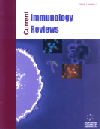-
oa Editorial [Hot topic: NKT Cell Therapy (Guest Editor: Masashi Emoto)]
- Source: Current Immunology Reviews (Discontinued), Volume 6, Issue 2, May 2010, p. 76 - 77
-
- 01 May 2010
Abstract
The NKT cells represent an intriguing subset of T lymphocytes co-expressing NKR-P1B/C (NK1.1)(CD161), which are clearly distinct from conventional T cells. The majority of NKT cells express an invariant (i) T cell receptor (TCR), typically comprising Vα14/Jα18 combined with a highly skewed TCRVβ towards Vβ8.2 in the mouse, and homologous chain Vα24/Jα18 paired with Vβ11 in the human (iNKT cells). Unlike conventional T cells which are selected by polymorphic major histocompatibility complex (MHC) class I or class II expressed on the surface of thymic stromal cells, iNKT cells develop dependently on nonpolymorphic MHC class I-like antigen presentation molecule CD1d expressed on CD4+CD8+ cortical thymocytes. In contrast to conventional T cells, which recognize peptide antigens presented by MHC class I or class II, iNKT cells recognize glycolipid antigens such as α-galactosylceramide (α-GalCer), a synthetic glycolipid originally isolated from marine sponge in CD1d-dependent fashion. Upon activation (e.g. TCR ligation), iNKT cells promptly secrete large quantities of both type 1 and type 2 cytokines, and express cytolytic activity. The iNKT cells have been shown to participate in the regulation of various immune responses. Administration of α-GalCer into mice causes rapid release of various cytokines from iNKT cells, which participate in the prevention of various diseases (e.g. tumor rejection, prevention of the development of autoimmune diseases and protection against microbial pathogens). Indeed, clinical trial has just started for the treatment of patients suffering from cancer. Thus, it appears that iNKT cells are crucial target cells in the control of various diseases and that their ligands are highly expected as a new preventive/therapeutic medicine. In this issue, Drs. Kazuya Iwabuchi, Luc van Kaer, Hiroshi Wakao, Shin-ichiro Fujii and Yuki Kinjo, leading scientists in the field of iNKT cells, review whether and how iNKT cells can control autoimmune diseases, infectious diseases and cancer. Dendritic cells are essential for iNKT cell activation because they express CD1d on their surface at bright intensity and have a great potential to present glycolipid antigens to iNKT cells. Dr. Iwabuchi et al. describe an immunotherapy by manipulating iNKT cells with cytokine-pretreated dendritic cells. They provide us information on a unique method to potentiate a biased response by iNKT cells to enhance selectively type 1- (e.g. IFN-γ) or type 2-cytokine (e.g. IL-4) production with IL-4- or IFN- γ-pre-treated dendritic cells, respectively, and discuss possible mechanisms shared by these pre-treatments and therapeutic applications to tumor immunity, infectious diseases and autoimmune diseases. A prominent antigen for iNKT cells is α-GalCer. α-glucuronosylceramide from Sphingomonas sp. and Ehrlichia sp., α- galactosyldiacylglycerol from Borrelia sp., phosphatidylinositol mannoside from Mycobacterium sp. and phosphoethanolamine have been identified as possible ligands for iNKT cells, although all of these activate iNKT cells to a lesser degree than α- GalCer. Numerous investigators have been trying to identify a natural ligand for iNKT cells and some synthetic glycolipids have been identified as a ligand for iNKT cells. Dr. van Kaer et al. describes iNKT cell ligands and focus on the therapy of autoimmune diseases such as type 1 diabetes mellitus, multiple sclerosis, rheumatoid arthritis, systemic lupus erythematosus, primary biliary cirrhosis, myasthenia gravis, autoimmune uveritis, Graves' disease, etc. by controlling iNKT cell activation. Although iNKT cells are abundant in the liver and the bone marrow as compared to other organs and peripheral blood, these cells are far less abundant in the total body as compared to conventional T cells. The rarity of iNKT cells has not only hindered deciphering the molecular mechanisms underlying their immunomodulatory functions, but also prevented the direct use in cell therapy/regenerative medicine. Dr. Wakao gives a picture of induction of immunocompetent iNKT cells from embryonic stem cells, which may open the avenue for the future cell therapy/regenerative medicine using iNKT cells. On the one hand, iNKT cells play a major role in induction of immune responses, but on the other hand, they also participate in induction of immunological tolerance. Yet, an approach to manipulate the dual nature of iNKT cell function has not apparently been established. Dr. Fujii et al. describe two strategies inducing the opposite immune responses. In addition, they show several types of α-GalCer-pulsed antigen presenting cells (APCs) that generate stimulatory iNKT cells capable of releasing proinflammatory cytokines and leading to adaptive immune responses. Moreover, they give us information on immune modulation approach using liposomal α-GalCer, which generates regulatory iNKT cells. These regulatory iNKT cells induce regulatory T cells (Treg) and hence, this approach can be applied for diminution of excessive immune responses as is seen in autoimmune diseases as well as allergic diseases.


